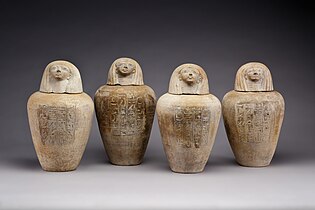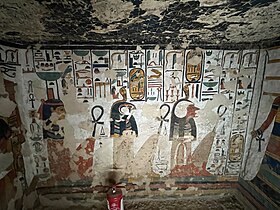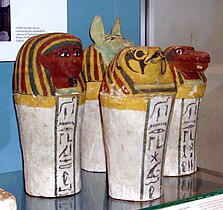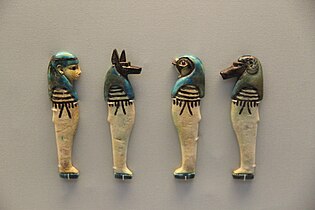Four sons of Horus
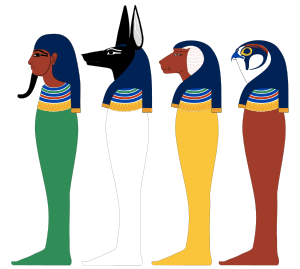
The four sons of Horus were a group of four
The worship of the sons of Horus was almost entirely restricted to the funerary sphere. They were first mentioned late in the
Names and origins
| Four sons of Horus[1] in hieroglyphs | |||||||
|---|---|---|---|---|---|---|---|
Imsety | |||||||
Hapy | |||||||
Duamutef | |||||||
Qebehsenuef | |||||||
Imsety (jmstj), Hapy (ḥpy), Duamutef (dwꜣ-mwt.f), and Qebehsenuef (qbḥ-snw.f)[2] are first mentioned in the Pyramid Texts, the earliest ancient Egyptian funerary texts, in the late Old Kingdom (24th and 23rd centuries BC).[3] In numerous sources, such as Spell 541 of the Pyramid Texts, they are stated to be the children of Horus, one of the major deities of the Egyptian pantheon.[4][5] In a few of these texts they are instead called the children of the god Atum, the god Geb, or the goddess Nut.[6] A passage in the Coffin Texts from the Middle Kingdom (c. 2055–1650 BC) says they are the offspring of the goddess Isis and a form of Horus known as Horus the Elder.[7]
In the Pyramid Texts, the sons of Horus are said to assist the deceased king in the afterlife.[8] In Spell 688, for example, they "make firm a ladder" for the king to ascend into the sky, while in Spell 338 they protect him from hunger and thirst.[9] Egyptologists often treat the protection of the deceased as their primary role, though Maarten Raven argues that the four sons originated as celestial deities, given that the Pyramid Texts frequently connect them with the sky and that Horus himself was a sky deity.[10]
The name of Duamutef means "He who praises his mother",
The name of Imsety incorporates the Egyptian grammatical dual ending (-ty or -wy), and the name of Hapy may have originally done so as well, incorporating a w that was later lost. For this reason, the Egyptologist John Taylor argues that these two sons were originally two male and female pairs of deities.[16]
Roles
Protectors of the deceased
Texts from later periods continue to invoke the sons of Horus for protection in the afterlife as the Pyramid Texts do. In many texts they were said to protect
The four sons developed a specialized connection with the internal organs of the deceased. During the
The sons of Horus themselves were thought to be under the protection of four goddesses, usually Isis for Imsety,
Directions and regions of the cosmos
The sons of Horus were also connected with the sky or parts of the cosmos as the Egyptians envisioned it. In the New Kingdom, they were sometimes thought of as stars in the northern sky[24] or as birds flying to the four corners of the world.[10] Bernard Mathieu suggests that they were equated with the four stars at the corners of the constellation Orion (Saiph, Betelgeuse, Bellatrix, and Rigel) and with four of the stars in Ursa Major (Megrez, Phecda, Merak, and Dubhe).[25]
Several Egyptologists have suggested that the four sons were equated with the four pillars that supported the vault of the sky in Egyptian cosmology.
Egyptian beliefs drew analogies between the human body and the cosmos, and these analogies were particularly visible in burial customs. In Middle Kingdom burials, bodies were laid out with the head to the north and the feet to the south. The texts that decorated coffins in this period placed some deities in consistent locations, thus linking them with particular directions. Imsety and Hapy were invoked at the head of the coffin, with Imsety on the left and Hapy on the right, thus placing Imsety in the northeast and Hapy in the northwest. Duamutef and Qebehsenuef were invoked at the foot of the coffin, with Duamutef on the left and Qebehsenuef on the right, thus placing Duamutef in the southeast and Qebehsenuef in the southwest. Canopic chests of the time placed each deity in equivalent positions. These orientations suggest that the sons of Horus were linked with the four corners of the Egyptian cosmos. Their orientation may be related to the positions of each organ: the lungs and liver sit higher in the body, thus fitting the northerly position of Imsety and Hapy, while the stomach and intestines are lower down, matching the southerly position of Duamutef and Qebehsenuef.[26]
The sons' positions shifted in the New Kingdom, when burials came to be laid out with the head to the west and the feet in the east. On some coffins, Imsety and Hapy remained at the head and Duamutef and Qebehsenuef at the foot, but in each pair, the deity who had been on the left side was moved to the right, and vice versa. In other cases, each of the sons of Horus appeared on a side wall of the coffin or canopic chest: Imsety in the south, Hapy in the north, Duamutef in the east, and Qebehsenuef in the west. The latter placement, with the sons of Horus on four sides rather than four corners, links the four deities with the
Iconography
The lids of canopic jars began to be sculpted in the shape of heads at the end of the First Intermediate Period, at the same time that the jars' inscriptions began to invoke the sons of Horus. These lids are therefore probably meant to represent the four sons rather than the organs' deceased owner.[28] In some of the earliest examples, the lids have falcon heads, but in the Middle Kingdom, human heads became the norm.[22] In some of these cases, Imsety, unlike the others, is portrayed as a woman.[29]
In the Eighteenth Dynasty (c. 1550–1292 BC), a few canopic jars were given varying heads: Imsety was portrayed as a man, Hapy as a baboon, Duamutef as a jackal and Qebehsenuef as a falcon.[30] This iconography became standard during the reign of Ramesses II in the thirteenth century BC[29] and remained so for the rest of ancient Egyptian history, although in the Third Intermediate Period the animal forms were frequently confused. For instance, Duamutef was often portrayed as a falcon and Qebehsenuef as a jackal.[4]
In addition to the jars themselves, the four sons were often portrayed on the canopic chests that housed the jars, as well as on coffins and other burial equipment.
-
A canopic chest with human-headed jars, from the Middle Kingdom (c. 2055–1650 BC)
-
Human-headed canopic jars from the early Eighteenth Dynasty, c. 1504–1447 BC
-
Qebehsenuef (center) and Hapy (right), depicted in the tomb of Nefertari (QV66), c. 1250 BC
-
Animal-headed canopic jars from the Twenty-fifth Dynasty (c. 744–664 BC)
-
Amulets of the four sons of Horus from theThird Intermediate Period(c. 1070–664 BC)
Worship
The four sons did not receive the regular cultic worship that major Egyptian deities did, and they appeared exclusively in funerary contexts.
In the Twentieth Dynasty of the New Kingdom (1189–1077 BC), embalmers began placing wax figurines of the sons of Horus inside the body cavity.[33] Soon afterward, at the beginning of the Third Intermediate Period, Egyptians ceased to store organs in canopic jars and instead embalmed each organ separately, wrapping them together with the corresponding wax figurines and returning them to the body cavity. Wealthy burials continued to include canopic jars with no organs inside.[34] Toward the end of this period, the four sons were also portrayed in faience amulets attached to the exterior wrappings of the mummy.[35] During this period, the decoration of human-shaped coffins placed the four sons near the abdomen of the mummy rather than distributing them around the coffin, a sign that their connection with the internal organs was overshadowing their other roles.[36]
The use of canopic jars ceased in the early
Citations
- ^ Hart 2005, p. 150.
- ^ Dodson 2001, p. 561.
- ^ a b c Wilkinson 2003, p. 88.
- ^ a b c d e f g h i j k Dodson 2001, p. 562.
- ^ Allen 2015, p. 175.
- ^ Mathieu 2008, pp. 8–9.
- ^ Faulkner 1973, p. 135.
- ^ Dodson 2001, pp. 561–562.
- ^ Allen 2015, pp. 78, 286.
- ^ a b c Raven 2005, p. 42.
- ^ Roberson 2013, p. 20.
- ^ Ikram & Dodson 1998, pp. 291–292.
- ^ Allen 2015, pp. 357–358.
- ^ Roberson 2013, p. 39.
- ^ Mathieu 2008, p. 11.
- ^ Taylor 2001, p. 65.
- ^ Goelet et al. 2015, p. 169.
- ^ a b Pinch 2002, p. 204.
- ^ Geisen 2018, p. 240.
- ^ Ikram & Dodson 1998, pp. 276, 278.
- ^ Taylor 2001, p. 66.
- ^ a b Ikram & Dodson 1998, p. 278.
- ^ Raven 2005, p. 44.
- ^ Wilkinson 2003, p. 89.
- ^ Mathieu 2008, p. 13.
- ^ Raven 2005, pp. 41–43, 47, 52.
- ^ Raven 2005, pp. 43, 52.
- ^ Taylor 2001, p. 67.
- ^ a b Taylor 2001, p. 68.
- ^ Ikram & Dodson 1998, p. 284.
- ^ Geisen 2018, pp. 279–280.
- ^ Taylor 2001, p. 127.
- ^ a b c Dodson 2001, p. 563.
- ^ Ikram & Dodson 1998, p. 289.
- ^ Dodson 2001, pp. 562–563.
- ^ Raven 2005, p. 43.
- ^ Ikram & Dodson 1998, p. 292.
- ^ Smith 2009, p. 217, 222.
Works cited
- ISBN 978-1-62837-114-7.
- ISBN 978-0-19-510234-5.
- ISBN 978-0-85668-005-2.
- Geisen, Christina (2018). A Commemoration Ritual for Senwosret I: P. BM EA 10610.1–5/P. Ramesseum B (Ramesseum Dramatic Papyrus). Yale Egyptological Institute. ISBN 978-0-9740025-9-0.
- Goelet, Ogden; Faulkner, Raymond O.; Andrews, Carol A. R.; Gunther, J. Daniel; ISBN 978-1-4521-4438-2.
- Hart, George (2005). The Routledge Dictionary of Egyptian Gods and Goddesses, Second Edition. Routledge. ISBN 978-0-203-02362-4.
- ISBN 978-0-500-05088-0.
- Mathieu, Bernard (2008). "Les Enfants d'Horus, théologie et astronomie" (PDF). Égypte Nilotique et Méditerranéenne (in French). 1: 7–14.
- ISBN 978-0-19-517024-5.
- S2CID 162109010.
- Roberson, Joshua Aaron (2013). The Awakening of Osiris and the Transit of the Solar Barques: Royal Apotheosis in a Most Concise Book of the Underworld and Sky. Editions Universitaires Friborg Suisse / Vandenhoeck & Ruprecht Göttingen. ISBN 978-3-7278-1746-5 / ISBN 978-3-525-54387-0
- Smith, Mark (2009). Traversing Eternity: Texts for the Afterlife from Ptolemaic and Roman Egypt. Oxford University Press. ISBN 978-0-19-815464-8.
- Taylor, John (2001). Death and the Afterlife in Ancient Egypt. University of Chicago Press. ISBN 978-0-226-79164-7.
- ISBN 978-0500051207.
External links
 Media related to Four sons of Horus at Wikimedia Commons
Media related to Four sons of Horus at Wikimedia Commons

![A vignette in the Book of the Dead of Ani (c. 1250 BC) depicts a personified canopic chest flanked by the sons of Horus.[17]](http://upload.wikimedia.org/wikipedia/commons/thumb/0/0b/Bookofthedeadspell17.jpg/700px-Bookofthedeadspell17.jpg)

